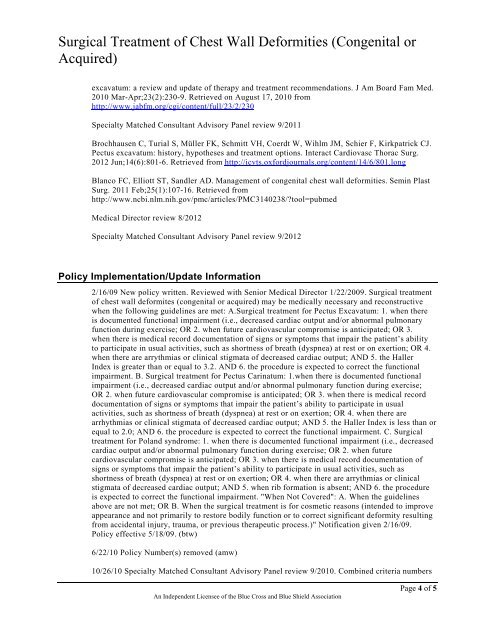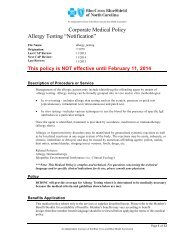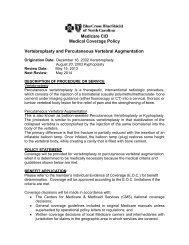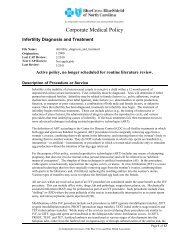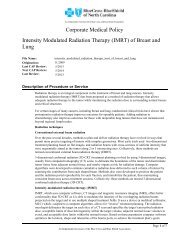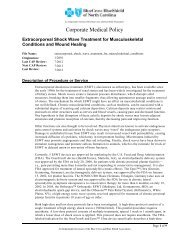Surgical Treatment of Chest Wall Deformities - Blue Cross and Blue ...
Surgical Treatment of Chest Wall Deformities - Blue Cross and Blue ...
Surgical Treatment of Chest Wall Deformities - Blue Cross and Blue ...
You also want an ePaper? Increase the reach of your titles
YUMPU automatically turns print PDFs into web optimized ePapers that Google loves.
<strong>Surgical</strong> <strong>Treatment</strong> <strong>of</strong> <strong>Chest</strong> <strong>Wall</strong> <strong>Deformities</strong> (Congenital or<br />
Acquired)<br />
excavatum: a review <strong>and</strong> update <strong>of</strong> therapy <strong>and</strong> treatment recommendations. J Am Board Fam Med.<br />
2010 Mar-Apr;23(2):230-9. Retrieved on August 17, 2010 from<br />
http://www.jabfm.org/cgi/content/full/23/2/230<br />
Specialty Matched Consultant Advisory Panel review 9/2011<br />
Brochhausen C, Turial S, Müller FK, Schmitt VH, Coerdt W, Wihlm JM, Schier F, Kirkpatrick CJ.<br />
Pectus excavatum: history, hypotheses <strong>and</strong> treatment options. Interact Cardiovasc Thorac Surg.<br />
2012 Jun;14(6):801-6. Retrieved from http://icvts.oxfordjournals.org/content/14/6/801.long<br />
Blanco FC, Elliott ST, S<strong>and</strong>ler AD. Management <strong>of</strong> congenital chest wall deformities. Semin Plast<br />
Surg. 2011 Feb;25(1):107-16. Retrieved from<br />
http://www.ncbi.nlm.nih.gov/pmc/articles/PMC3140238/?tool=pubmed<br />
Medical Director review 8/2012<br />
Specialty Matched Consultant Advisory Panel review 9/2012<br />
Policy Implementation/Update Information<br />
2/16/09 New policy written. Reviewed with Senior Medical Director 1/22/2009. <strong>Surgical</strong> treatment<br />
<strong>of</strong> chest wall deformites (congenital or acquired) may be medically necessary <strong>and</strong> reconstructive<br />
when the following guidelines are met: A.<strong>Surgical</strong> treatment for Pectus Excavatum: 1. when there<br />
is documented functional impairment (i.e., decreased cardiac output <strong>and</strong>/or abnormal pulmonary<br />
function during exercise; OR 2. when future cardiovascular compromise is anticipated; OR 3.<br />
when there is medical record documentation <strong>of</strong> signs or symptoms that impair the patient’s ability<br />
to participate in usual activities, such as shortness <strong>of</strong> breath (dyspnea) at rest or on exertion; OR 4.<br />
when there are arrythmias or clinical stigmata <strong>of</strong> decreased cardiac output; AND 5. the Haller<br />
Index is greater than or equal to 3.2. AND 6. the procedure is expected to correct the functional<br />
impairment. B. <strong>Surgical</strong> treatment for Pectus Carinatum: 1.when there is documented functional<br />
impairment (i.e., decreased cardiac output <strong>and</strong>/or abnormal pulmonary function during exercise;<br />
OR 2. when future cardiovascular compromise is anticipated; OR 3. when there is medical record<br />
documentation <strong>of</strong> signs or symptoms that impair the patient’s ability to participate in usual<br />
activities, such as shortness <strong>of</strong> breath (dyspnea) at rest or on exertion; OR 4. when there are<br />
arrhythmias or clinical stigmata <strong>of</strong> decreased cardiac output; AND 5. the Haller Index is less than or<br />
equal to 2.0; AND 6. the procedure is expected to correct the functional impairment. C. <strong>Surgical</strong><br />
treatment for Pol<strong>and</strong> syndrome: 1. when there is documented functional impairment (i.e., decreased<br />
cardiac output <strong>and</strong>/or abnormal pulmonary function during exercise; OR 2. when future<br />
cardiovascular compromise is anticipated; OR 3. when there is medical record documentation <strong>of</strong><br />
signs or symptoms that impair the patient’s ability to participate in usual activities, such as<br />
shortness <strong>of</strong> breath (dyspnea) at rest or on exertion; OR 4. when there are arrythmias or clinical<br />
stigmata <strong>of</strong> decreased cardiac output; AND 5. when rib formation is absent; AND 6. the procedure<br />
is expected to correct the functional impairment. "When Not Covered": A. When the guidelines<br />
above are not met; OR B. When the surgical treatment is for cosmetic reasons (intended to improve<br />
appearance <strong>and</strong> not primarily to restore bodily function or to correct significant deformity resulting<br />
from accidental injury, trauma, or previous therapeutic process.)" Notification given 2/16/09.<br />
Policy effective 5/18/09. (btw)<br />
6/22/10 Policy Number(s) removed (amw)<br />
10/26/10 Specialty Matched Consultant Advisory Panel review 9/2010. Combined criteria numbers<br />
An Independent Licensee <strong>of</strong> the <strong>Blue</strong> <strong>Cross</strong> <strong>and</strong> <strong>Blue</strong> Shield Association<br />
Page 4 <strong>of</strong> 5


